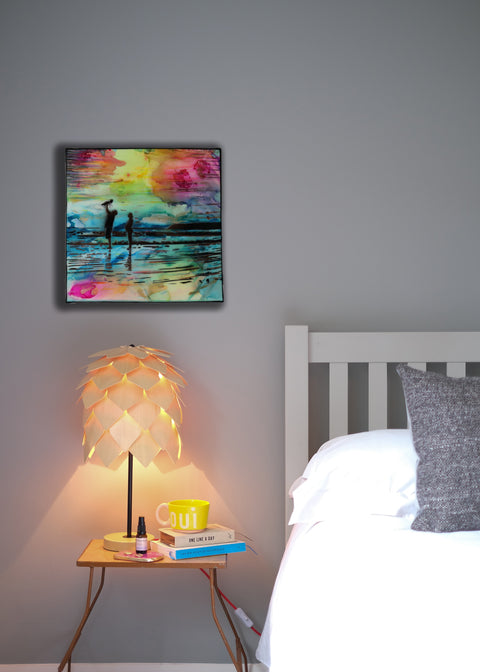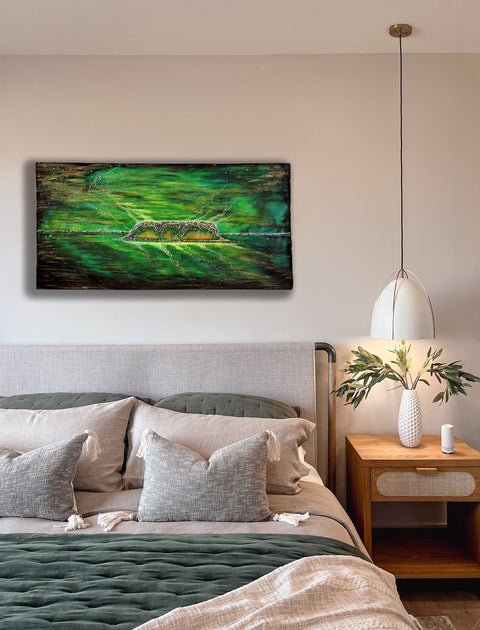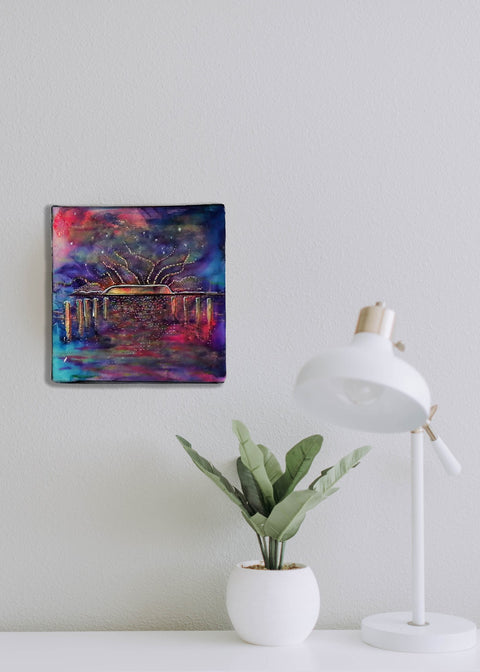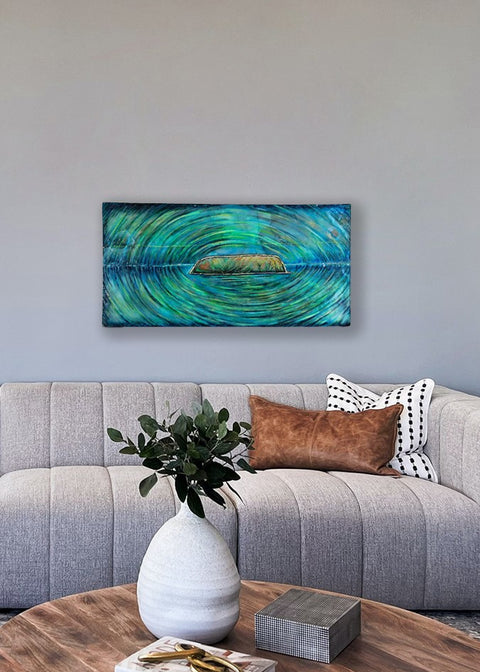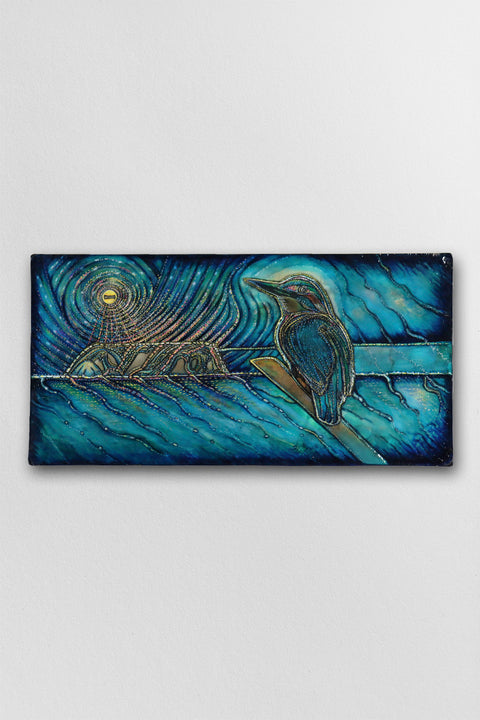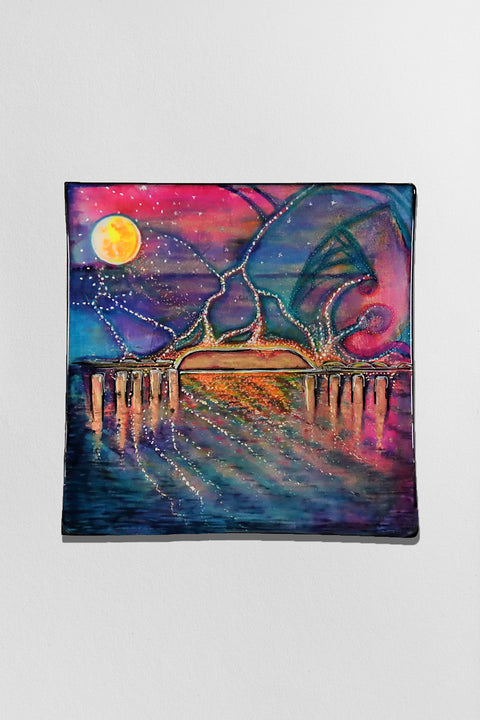Mighty Mana Island Paintings
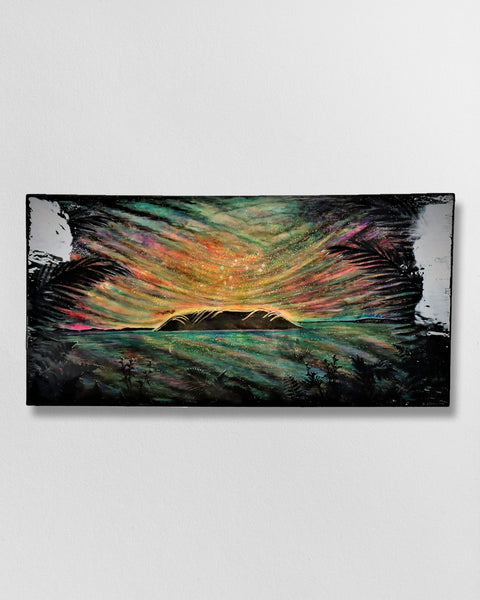
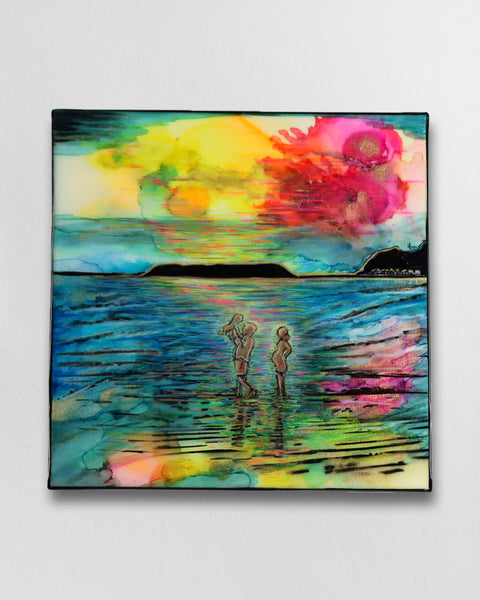
This collection of paintings is of the many stunning views of the mighty Mana Island from Plimmerton, Porirua, Wellington.
Mana: (noun) prestige, authority, control, power, influence, status, spiritual power, charisma - mana is a supernatural force in a person, place, or object. Mana goes hand in hand with tapu, one affecting the other.
History
Mana Island formed 200,000 years ago during an interglacial period. The island is now a scientific, predator free reserve, is about 2000 acres and is located off the west coast of Plimmerton, Porirua, Wellington, New Zealand.
Plimmerton is a stunning wee beachside village and a historic settlement.
Plimmerton was known as Tāupo and was home to the great Chief Te Rauparaha who was abducted and imprisoned without charge by the British in 1846.
In 1894 the Plimmer family built the 32-room Plimmerton House, which still stands today. Tāupo became known as Plimmerton named after John Plimmer, whom Prime Minister Richard Seddon called the father of Wellington.
Timeline
700-900 Kupe the great Polynesian explorer first lands on Mana Island. To commemorate the safe journey from Rarotonga to New Zealand, Kupe named the Island ‘Te Mana o Kupe ki te Moana Nui a Kiwa,’ which translates to the prestige of Kupe who crossed the great ocean of the Pacific.
1100-1300 Mana Island becomes part of the occupied area of the Ngati-Tara and Ngati-Ira tribes.
1275 Carbon dated evidence shows forest burning to grow crops on the island. For centuries Mana Island was a stop-over for Māori wakas making their way from Porirua to the South Island. Artefacts, like fishhooks, spears, animal remains were found buried rubbish heaps - which date back to the 14th century.
1773 or 1777 Captain James Cook, on board the Endeavour saw Mana and named it Table Island.
1800-1830 Whalers stop for shelter, trade, and use Mana’s view to spot whales to hunt. The traders and whalers' names for the island are Manno, Manna and Marna. A whaling station is run from the Island as it was a convenient place for boiling blubber with plenty of driftwood on the shore. The whaling station was operational until about 1845.
1820-23 Te Rauparaha is the chief of the local Ngāti Toa tribe. His nephew, Te Rangihaeata, settles on Mana Island with his mother Waitohi. Waitohi was the eldest sister of Te Rauparaha and distinguished leader of Ngāti Toa and Ngāti Raukawa tribes in her own right. Noble Waitohi was an influential voice for her people, her views were heeded by Te Rauparaha during the troubled times of the southward migration and resettlement.
1826-29 Te Rangihaeata built a celebrated Whare Whakairo (carved meeting house) on Mana Island named Kaitangata. Whare Whakairo represents Māori cosmology or view of the universe, inside the house lies Te Pō, the world of darkness, while the exterior represents Te Ao Mārama, the world of light, clarity, and growth. The whare was situated on the lower eastern side of the island, just off the shoreline and likely the main building of the Ngāti Toa settlement. The house was elaborately carved with figures representing Te Rangihaeata and is said to be carved by Te Rangihaeata himself. The name Kaitangata means man-eater. In Māori mythology, Kaitangata is either a mortal son of Māui, or a son of star-God Rehua. Kaitangata, the son of Māui, is an industrious man who married the female supernatural being Whaitiri. Kaitangata is also a snail, a Cats Eye or Turbinidae mollusc and would have been common on Mana Island and is traditional Māori food.
Te Rauparaha also built a whare and lived on Mana Island, but his main island base was Kapiti Island - further north up the coast.
1827 A Royal Navy 76 gun warship HMS Warspite visited the area. Captain Richard Saunders Dundas names Mana Warspite Island after his ship.
1832 Most of the vegetation was cleared for one of New Zealand’s first farms. Mana Island was leased from Ngāti Toa by Alexander Davidson, John Bell, and Archibald Mossman for sheep farming in exchange for £24 worth of goods consisting of one six-pound carronade, two swivel guns, two kegs of gunpowder and two chests.
John Bell was the first European settler on the island. He had 103 merino sheep, 10 cattle, and 2 and 2/2 ton of hay, seed, fruit trees and tobacco delivered to Mana Island, aboard the ship Martha. It was the first provincial sheep farm, and farming began on the island.
Te Rauparaha sends a tohunga to John Bell to ensure as agreed; that parts of Mana Island remain tapu, traditional food remains accessible, and the Ngāti Toa settlement on Mana Island is treated well.
Cattle provide milk and beef to the whaling trade, which is booming. But the industry is short lived, as whale numbers significantly dwindle due to over hunting.
May 1836 Excerpt from the ‘Stories of Banks Peninsula' gives the following account of an early visit to Mana Island; I may state that I arrived in New Zealand in May, 1836, in the whaling ship Louisa, of Sydney, Captain Haywood. We anchored under Mana Island, in Cook Strait, where the ship remained during the bay whaling season, from May to October. Te Rauparaha was our chief, or we were under his protection, for which he was well paid in blankets, etc. Although he was a terror among the Natives, he was always very good to the whites; in fact, in one instance I have to thank him for saving my life. It happened this way: I was ashore with a boat’s crew, filling water casks, when Te Rauparaha’s son, a lad about sixteen years of age, was very troublesome to our men, and annoyed them so much that one of the crew, in a hasty moment, struck young Rauparaha in the face, and made his nose bleed. Now, to draw the blood from a chief was one of the greatest crimes that could be committed, and the transgressor very seldom escaped with his life. When the Natives saw the blood they were very much excited, and came rushing upon the crew, flourishing their tomahawks. We all thought our last hour had come. Old Rauparaha, hearing the noise, came out of his hut to see what was up. On hearing the particulars he told the Natives not to touch the white men, for his son was in the wrong. He must take his own part and fight the pakeha (European) – very good, one Maori, one pakeha. It ended in a stand-up fight, in which, to our delight, young Rauparaha got a good thrashing, and we were thankful to get off with our lives. However, young Rauparaha soon forgot it, and we were ever afterwards the best of friends. Had not old Rauparaha been at hand, I am afraid it would have been a serious matter for us.”
October 1836 A Māori chief is killed during a disagreement over trading, while on the whaling barque Caroline. This triggered tension between Māori and Pakeha in the area. The following is an excerpt from Robert McNab’s’ book, The Old Whaling Days: Commotions among the Natives. At and some- time prior to sailing from Entry Island, the Natriaora tribe were disposed to exercise hostilities towards the shipping at Flat (Mana) Island, also the European residents adjacent thereto. A Native Chief brought supplies of potatoes, etc., to a barque from the port of Hobart Town (the Caroline) the payment offered did not satisfy him; observing a small tomahawk in one of the boats, he took possession of it, judging it and the payment already made, adequate in value to the property delivered. On being requested to restore the tomahawk, he declined; a scuffle ensued between the Chief and the first officer of the barque; meanwhile one of the boat's crew deliberately took a lance, and thrust it through the Chief's body, immediately under the right breast, of which he shortly died.’ Intervening this affair and the date of my sailing thence (October 13th), whalers, while cruising in their boats, were repeatedly fired at by the natives, among whom was Captain Cherry, of the barque Caroline, of this port. Fortunately, they escaped unhurt.
1838 John Bell dropped dead. As there are no planks of wood on Mana Island, he's buried there in a rum barrel. I know it's twisted but I particularly love that story. Following his death, his two third share in the island passed to his father Thomas Bell, who then sold it to Henry Moreing for £750. Moreing acquired the remainder of the island from Peterson for £250 in 1841.
Ngāti Toa rightly dispute Moreing's claim of ownership of Mana Island. Ngāti Toa agreed that John Bell could use Mana Island to farm, but that did not yield the result of Bell to claim ownership.
27 August 1838 Captain Samuel Cherry of the whaling ship Caroline was killed on Mana Island allegedly by Māori Chief Mitikakau in retaliation for the murder of the chief in 1836. The following is an excerpt from Robert McNab’s’ book, The Old Whaling Days. In July 1838, Tom Ellison of Mana was involved in an argument with the captain of the Caroline, a Captain Cherry. According to George Potter, the boat-steerer, Ellison, or Thomas as he was called, threatened to break Captain Cherry's head with a stick if he ever landed on Mana Island. On 27 August 1838, the Caroline visited Mana Island and Captain Cherry went ashore with a native to look out to sea for whales. He was found murdered, and suspicion fell on Mr. Thomas, as he was known, who owned a whaling establishment that was only half a mile from the murder. Lieutenant Chetwode of the HMS Pelorus sent for and closely examined Ellison but came to the conclusion that he was not concerned in the murder. The native who had gone ashore with Captain Cherry was later found to have murdered him for his fine clothes, which he was wearing when he was arrested.
1839 Waitohi died on Mana Island. It is said a disagreement at her tangi later sparked a battle between the Te Āti Awa and Ngāti Raukawa tribes. Waitohi is entombed in an elaborately carved mausoleum on Mana Island. This is sketched in 1844 by a visiting artist George French Angas.
16 October 1839 The New Zealand Company ship Tory arrived at Kāpiti. Colonel William Wakefield wanted to buy vast tracts of land. Te Rauparaha accepted guns, blankets and other goods for land in Whakatū and Te Taitapu, in Nelson and Golden Bay areas at the top of the South Island.
30 January 1840 Land purchases prohibited. All land sales were declared void by Lieutenant Governor William Hobson, and a commission was set up to investigate land claims.
Major Thomas Bunbury sailed around New Zealand on the HMS Herald obtaining signatures for To Te Tiriti o Waitangi. His sheet became known as the Herald (Bunbury) Sheet. With him was Edward Williams, son of Missionary Henry Williams and co-translator of the Treaty into Māori. Reverend Henry Williams had translated the treaty himself, with the help of his son, drawing on the te reo Māori he learnt in his 17 years working as an Anglican missionary in the Bay of Islands. However, his Māori version of the treaty, known as Te Tiriti o Waitangi, did not clearly reflect the English version. Reverend Henry Williams interpreted it and explained it to Māori rangatira in the best possible light.
14 May 1840 Te Rauparaha signed a copy of the Treaty of Waitangi (Cook Strait sheet of Te Tiriti) at Kāpiti. It was presented to him by CMS missionary Henry Williams.
26 May 1840 4.40am the first recorded earthquake and aftershocks are recorded in Wellington.
19 June 1840 Major Bunbury left the South Island to sail to Kāpiti on HMS Herald. When Bunbury and Te Rauparaha met at sea off Mana Island, Bunbury asked Te Rauparaha to sign the Herald copy of the treaty of Waitangi. When Te Rauparaha said he had signed missionary Reverend Henry Williams’ copy, Bunbury insisted that he also sign his copy. Accompanied by Te Rauparaha and Edward Williams the translator, Bunbury went to Mana Island to find Te Rangihaeata. Te Rangihaeata was assisted aboard the Herald and signed the Herald sheet of the Treaty of Waitangi.
Te Rauparaha and Te Rangihaeata believed that the treaty would guarantee their Iwi and their allies the possession of their territories.
Major Bunbury refused to allow Ria Waitohi, who was the daughter of paramount chief Te Pēhi Kupe, to sign the Treaty at Kapiti because she was a woman. Chief Rawiri Puaha, her husband, then refused to sign at Cloudy Bay because of the affront to the mana of his wife.
1843 The purchase of Mana Island was investigated by Land Commissioner Spain, who awarded the title to Moreing - despite Ngāti Toa disputing Moreing's claim of ownership.
Te Rauparaha soon became alarmed at the flood of British settlers and refused to part with any more land.
The New Zealand Company brought 15,500 European settlers to New Zealand with the promise of land between 1840 and 1852.
Edward Gibbon Wakefield was the architect of the New Zealand Company, and his brother Captain Arthur Wakefield was the agent based in Nelson. Colonel William Wakefield led the first colonising expedition to New Zealand and is considered one of the 'founders' of Wellington.
The Wakefield brothers of England had questionable pasts.
At the age of 20 in 1816, Edward eloped to Edinburgh, Scotland with a 17-year-old heiress, Eliza Pattle. To avoid public disgrace, her mother accepted the marriage and settled £70,000 on the young couple. Eliza died four years later in 1820 after giving birth to her third child. Wakefield had political ambitions and needed an estate to enter parliament. Employing forgery and perjury he attempted to overturn his father-in-law's will to gain control of the remainder of Eliza's estate. On 14 May 1827 Edward and his brother William Wakefield were imprisoned in England for 3 years. They were convicted of the abduction of the 15-year-old heiress Ellen Turner from her Liverpool boarding school. Edward forced her to marry him at Gretna Green in Scotland, presumably to gain her marriage dowry and/or inheritance. Wakefield expected the Turners to accept the marriage rather than face a public scandal. Instead, Ellen's Father went to London and asked for help from the Foreign Secretary. Learning that his daughter had been taken to the European mainland, Turner sent his brother to Calais, accompanied by a police officer and a solicitor. There they found the couple in a hotel. Edward Wakefield claimed that as they were legally married, Ellen could not be taken from him by force. After interviewing the girl, the French authorities let her leave the country with her uncle. The marriage was annulled by parliament. After his release from prison, Edward Wakefield became active in prison reform. He was involved in colonial affairs and had roles in the 'development' of South Australia, Canada, and New Zealand and enjoyed a distinguished political career in England.
The dubious land grabbing created tension which led to the 17 June Wairau Affray or attempted massacre of Te Rauparaha, Te Rangihaeata and Ngāti Toa iwi. After the signing of the Treaty of Waitangi this was the first serious clash of arms between British and Māori in New Zealand.
Edward Wakefield’s’ New Zealand Company sent surveyors to survey land in Wairau, which belonged to Ngāti Toa and wasn't for sale. Te Rauparaha and Te Rangihaeata tried to reason with the New Zealand Company to no avail. They peacefully escorted the surveyors back to their ships and removed the survey pegs. But the New Zealand Company persisted with the unlawful land grab, being 70,000 acres short of what it had sold to settlers.
Magistrate Thompson issued a warrant for the arrest of Te Rauparaha and Te Rangihaeata, and recruited forty-seven Special Constables, but most were just untrained labourers.
17 June 1843 Captain Arthur Wakefield and Magistrate Thompson ordered their ragtag constabulary, along with a group of settlers to arrest Te Rauparaha and Te Rangihaeata. They fired upon Te Rauparaha and his people, including children. Te Rongo, who was Te Rangihaeata’s wife and Te Rauparaha's daughter, was the first killed in the assault. In the affray that ensued 22 settlers and 4 to 9 Māori were killed. Most of the constabulary ran, but those who surrendered, including Arthur Wakefield and Henry Thompson, the two leaders of the arresting party, were executed. Te Rangihaeata ordered utu in customary accordance with killing Te Rongo, the attack on his people, and the Crowns failure to convict whaler Richard (Dick) Cook for the December 1842 brutal rape, mutilation, and murder Rangiawa Kuika, and killing her child and baby. Rangiawa Kuika was Te Rangihaeata’s niece.
The Wairau event showed the Treaty of Waitangi had not been upheld, nor had it guaranteed what Williams and Bunbury claimed when they persuaded the chiefs to sign the treaty.
The subsequent government enquiry exonerated Te Rauparaha and Te Rangihaeata. This further angered the settlers who began a campaign to have the governor Robert FitzRoy recalled.
When Land Commission Spain looked at the case in 1844, he declared that Ngāti Toa had not sold the land to the New Zealand Company.
Ngāti Toa left Marlborough.
Māori who stayed feared they would be attacked by Government forces.
Te Rangihaeata leaves Mana Island and doesn't ever return.
8 July 1843 A large earthquake badly affected Wanganui and was felt in Wellington.
12 February 1844 At Waikanae Governor Robert FitzRoy declared; that the settlers had provoked the fighting at Wairau and while he deplored the killing of the prisoners no further action would be taken.
1844 George French Angas the artist visited Mana Island and sketched Māori settlement including the incredible whare whakairo, Kai Tangata and the burial house of Waitohi.
31 March 1845 Land Commissioner Spain reports to Governor Fitzroy: deeds under which New Zealand Company asserted that it had acquired territories amounting to about one-third of the whole surface of New Zealand. During testimony it appeared that the late Captain Wakefield, immediately on his arrival with the preliminary expedition, assembled the resident Natives of the several districts in the immediate vicinity of Nelson and informed them that he was about to take possession of the land by virtue of a purchase made by Colonel Wakefield.
May 1846 The new governor George Grey decided that Te Rauparaha could not be trusted and must be arrested. He visited him at his Taupō pā in Plimmerton, then left on the naval vessel Driver. Two hours before dawn the ship returned, and British troops abducted Te Rauparaha. He was held without charge on another naval vessel, the Calliope, for 10 months and then 'allowed' to live in Auckland.
1847 Governor George Grey imposed the Porirua and Wairau deeds on the Ngāti Toa iwi following the government’s capture and detention of their principal chief, Te Rauparaha.
Ngāti Toa had been severely displaced and much of their land was alienated due to compulsory purchases. This was confirmed by the Crown’s apology within the Ngāti Toa deed of settlement. Seizure of important Ngāti Toa Rangatira reduced the power and influence of its leaders and allowed the Crown to coerce the unfair sale of Ngāti Toa land.
June 1848 On petition to the governor, Te Rauparaha was returned to his people at Ōtaki.
1.40am 16 October 1848 A sharp 7.5 magnitude earthquake struck the Wellington settlement during severe gales and heavy rain. It lasted for 2 minutes. Then strong vibrations followed for 10 minutes and continued for an hour afterwards. Judge Henry Chapman noted about 100 aftershocks between 1.40 a.m. and 6 a.m. Although the earthquake was centred in Awatere Valley, Marlborough at the top of the South Island, it caused substantial damage in the greater Wellington area. Over the next few days, the colonies were hit by 10 aftershocks. Two substantial aftershocks on 17 and 19 October were described by people as strong as or stronger than the initial earthquake and brought down buildings that had been damaged in the first quake.
27 November 1849 The great Chief Te Rauparaha dies Ōtaki, Te Upoko o te Ika, New Zealand.
1855 8.1 and 8.2 earthquakes on the Richter scale devastated areas of the Wairarapa and Wellington. The 9.17pm January 23 earthquake lasted for 50 seconds and resulted in the loss of a dozen lives. This number was low due to the time of the quake as well use of one level timber dwellings. The earthquake caused a tsunami in Cook Strait and Wellington Harbour.
18 November 1855 Chief Te Rangihaeata died from pneumonia after lying in a stream to reduce his fever caused by measles. He was buried at Poroutāwhao beside Te Pikinga in Horowhenua.
1864 A lighthouse was built on the northern end of Mana Island, the second lighthouse in greater Wellington. It was designed and prefabricated in London by Simpson and Co. and first lit on 1 February 1865. Unfortunately, 2 shipwrecks, the City of Newcastle in 1871, and Cyrus in 1874 were blamed on the Mana Island light, due to the confusion with the Pencarrow lighthouse. So, the Mana light was extinguished on the 24 September 1877. The 80-tonne lighthouse was dismantled into 92 pieces and moved to Cape Egmont. The lighthouse was resurrected on Cape Road in Pungarehu in Taranaki but wasn't lit until 1881. For the first six months an armed constabulary were stationed on the first floor of the lighthouse because of the Taranaki land wars at Parihaka. Cape Egmont Lighthouse was automated in 1986 and is still operational today.
Governor Grey and his ministers confiscated almost 3 million acres (1.2 million ha) of Māori land which was given to military settlers or sold to pay for the costs of the war he’d waged against Māori tribes.
1865 The Mana Island ownership dispute continued until 1865 when the Crown purchased Mana Island and paid £300 compensation to Ngāti Toa.
1873 Following the Crown purchase Mana Island was leased as a sheep farm for 100 years to J.F Wright 1873-1893, the Vella family 1893-1953.
1987 The Department of Conservation took over management of the island and began to restore Mana to its natural state.
The island provides shelter to many special insects, reptiles, birds, and plants. Its surrounding waters have abundant sea life.
Birds on the island include takahe, blue penguin, brown teal, diving petrel, fluttering shearwater, gannets, yellow-crowned parakeet, little spotted kiwi, and North Island robin.
Waikoko wetland, developed on Mana Island by DOC in 1998 is on the site of a wetland that was there before the island was developed as a farm in 1832. Waikoko means water of many tuis. The wetland provides habitat for brown teal and threatened wetland plants from the Cook Strait and Wellington districts.
Forest canopy being restored by a massive replanting programme thanks to the Friends of Mana Island and Forest and Bird.
Mice eradicated 1989-1990. Rats and other introduced predators never established on the island.
Significant location for Cook Strait giant weta, McGregor’s skink and goldstripe gecko.
Wellington green gecko, Duvaucel’s gecko and flax weevils have been introduced.
A sound system installed plays the calls of seabirds to help attract them. Returning seabirds are crucial as the burrows of the seabirds create safe, sheltered, and humid homes for lizards, tuatara, and insects.
A concrete gannet colony has been installed above the western cliffs to attract gannets to breed.
New colonies of seabirds are being established by transferring chicks from islands in the Marlborough Sounds and tricking them into thinking Mana Island is home. They’re placed in artificial burrows and hand fed sardine smoothies by volunteers until they fledge.
Mana: (noun) prestige, authority, control, power, influence, status, spiritual power, charisma - mana is a supernatural force in a person, place, or object. Mana goes hand in hand with tapu, one affecting the other.

